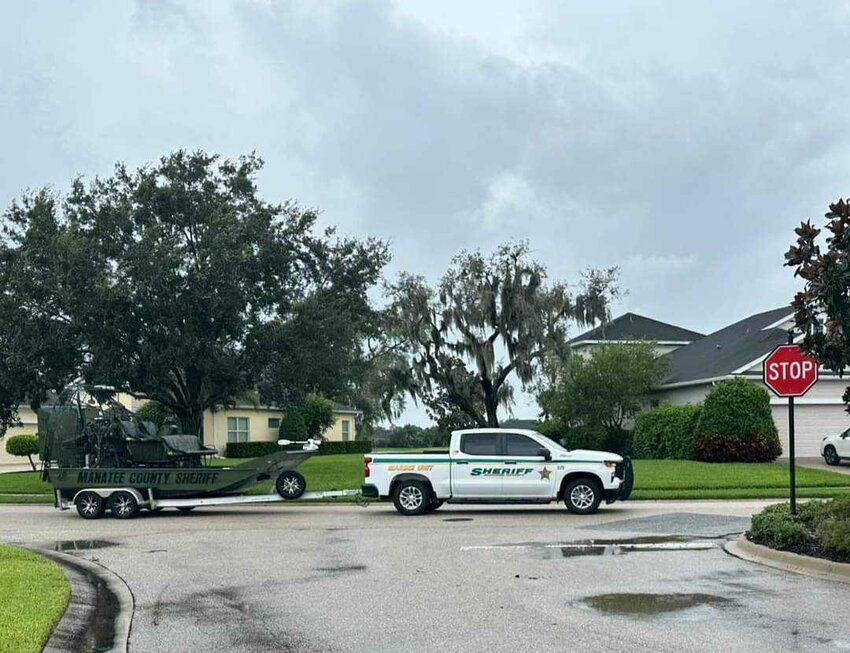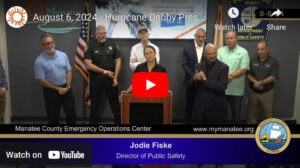
“My neighbor said they were pounding on my door and being persistent about it. I couldn’t believe it. I walked quickly to my house and arrived just as they were pulling away.”
Jessee was beginning to feel awful that important resources other residents in the county may have needed were being diverted to her—even though her house was not flooding.
She said she called 3-1-1 again and told them to “delete my address from your records.” Jessee said she repeated to the operator that she and her children were safe and did not need to be rescued.
About 30 minutes after her second call to 3-1-1, Jessee said her phone rang, and it was the fire department.
To her astonishment, she said they asked her, “How many people are on your roof?”
“They told me they received a call that there were people on my roof who needed to be rescued. I told them there were no people on my roof, that there were never any people on my roof,” she explained.
Rhodes and Jessee said their community never flooded, though the roads outside and surrounding their neighborhood did.
River Plantation resident Nicholas Azzara has lived in his community since 2015. Azzara once worked for Manatee County, leading public communication.
Azzara also received the IPAWS alerts but said the first alert didn’t concern him because of his experience working for the county.
“It’s not unusual for the county to release water from the dam during a storm event. Usually, they release water in advance of the storm as well,” he explained.
Azzara said he believed his home would not be in danger from a dam release, but when he received the second alert—two hours after the first—it startled him.
“I don’t recall in my many years working with the county ever drafting or sending a message to residents with capitalized words. Nor did we ever tell people to leave the area in the middle of a storm event,” he said.
Azzara explained that his inability to locate any other information on the county’s social media pages or website added to his concern.
“There was no information about exactly who was thought to be at risk and what locations,” he said.
He used Google Maps to identify a potential flood area, which helped him decide it was safer to stay at home rather than drive on the roads.
“I saw our home on the very outskirts of that flood zone, and I figured—I prayed—we would be safe.
His home never flooded.
Marian Bryan, Cheri Lindgren, Walter Wulczak, Josh Shear, and Adam L. are residents of Greyhawk Landing. Adam requested TBT use only the first initial of his last name.
Wulczak and Shear told TBT that they felt confident their neighborhood was not at risk.
“Knowing the location of the dam and the direction of flow, I didn’t think much of it. I understood the reasoning of the alert but figured it was a county-wide or a regional alert,” said Shear.
Wulczak said he was equally confident his home was safe but admitted the alerts caused significant confusion and real worry for many of his neighbors.
“I don’t think these alerts should have been sent to any homes in Greyhawk Landing,” Wulczak said. “The way they were written seemed the opposite of good emergency communication; they raised everyone’s stress levels.”
Bryan, Lindgren, and Adam L. told TBT the alerts were concerning, but after speaking with neighbors, they each decided that trying to evacuate wasn’t a good idea.
“All the roads were flooded out, and we couldn’t have left if we wanted to,” explained Adam.
“Several neighbors said they tried to call 3-1-1 but couldn’t get through.” Bryan shared.
Lindgren said she heard of residents who tried to leave but came upon flooded intersections once outside the community.
They all said they thought the county’s communication was lacking throughout the ordeal and that it was seasoned residents and neighbors who helped them evaluate the risk.
Shear had a slightly different perspective on the alerts than his neighbors did. He thinks the county did the best it could.
“It’s a tough situation to manage, and weather information can change quickly,” said Shear. “It’s important to keep the public informed during times of emergency, but also folks need to be prepared and have a plan.”
All of the Greyhawk residents we spoke to said their homes never flooded.
Twin Rivers resident Christine Fulton told TBT that she received the alerts and wished the county had provided a map showing the areas at risk from the dam release.
Fulton has lived in the Parrish Twin Rivers community for eight years.
“I understood the alert was telling us the county was going to do a release at the dam, but I did not understand why we were advised to leave,” Fulton said. “The alert did not provide pertinent information about the situation.”
Fulton said the alerts for tornadoes or flooding were beneficial, but the ones about the dam were confusing, and—based on where she lived—she didn’t think she would need to take action.
“Evacuating would have put me at greater risk than staying at home since my house didn’t experience flooding,” Fulton concluded.
Several streets in the Twin Rivers community received floodwater intrusion, TBT has not confirmed whether any homes were damaged.
Larry Luh, the former assistant chief of EMS operations at Manatee County, said he and his wife, Grace, also received the IPAWS alerts. The couple lives off Rye Road in east Manatee.
Luh retired in 2023 after more than 37 years with the county.
Concerning county communications, Luh said he and his wife weren’t impressed.
“As a longtime public safety employee and a Manatee County resident, the handling of this event deserves an “F,” said Luh bluntly. “Even under Scott Hopes during the Piney Point disaster or hurricanes, we had more intel than the county provided here.”
Luh expressed frustration that a press conference was not called and that local news wasn’t utilized to better inform residents about what was happening at the dam. He called the IPAWS alerts “confusing” and not enough.
According to Luh, dam releases are not uncommon occurrences during rain events, “Residents within a 10-mile radius of Lake Manatee should have been targeted. I can’t help but wonder about the total number of vehicles and citizens that may have needed to be rescued because they attempted to ‘run for the hills’ due to the county’s delivery of those IPAWS.”
“When people are uninformed, they start to panic,” Luh added.
Luh hopes the Manatee County Government and the Department of Public Safety can quickly improve their communication and delivery because three months remain in the 2024 Hurricane Season.
Tuesday
On Tuesday at 10:00 a.m., the county held a press conference from the EOC.
Commissioner Mike Rahn led the briefing and was joined by Florida Senator Rick Scott, Bradenton City Mayor Gene Brown, Manatee Sheriff Rick Wells, and Public Safety Director Jodi Fiske.
Most of the speaking was done by Rahn, more so than Public Safety Director Fiske.
Other officials stood by but never spoke, including Commissioners Kevin Van Ostenbridge and Ray Turner—both current candidates for office.
Seemingly absent was Chief of Emergency Management Matt Myers, who was not visible on camera and never spoke from the podium about the recently receded weather emergency.
In opening remarks, Rahn emphasized that the storm brought a “100-year flood,” repeating the descriptor.
A 100-year flood is a flood that has a 1% chance of occurring in any given year. It does not mean such a storm will only occur once every 100 years.

Screenshot
Concerning the dam, “The dam at Lake Manatee did its job,” Rahn said. “It automatically released into the spillway so that it could maintain safe levels at the lake.”
Rahn never used the words “strategic release.”
When a press member asked about residents who claimed they did not receive warnings about the release, Rahn responded, “We have lots of ways we can communicate.”
He listed reverse 911 calls, IPAWS alerts, social media, and the county government website as examples.
“I think our team did a very good job of sending information out to everyone that we could… there might be some residents who didn’t see it, didn’t hear it, or didn’t look on any of the social media that we sent it out on, but our public information team does a phenomenal job of getting this information out as fast as we can,” he said.
Rahn stressed that Monday’s events unfolded quickly but repeated that the dam “did what it was supposed to do” when its spillways “automatically opened up.”
Rahn invited Public Safety Director Fiske to the podium to answer questions about the dam release timeline, whether releases were done ahead of the storm, and the timing alerts.
Concerning the alerts, Fiske said they worked exactly as they should and were timed appropriately. All questions asked that were specific to the dam—including whether water was released in advance of the storm—Fiske instructed the press to “reach out to the dam operators,” who are the subject experts.
Later the same afternoon,
WFLA published a story that included a timeline it received from the county. According to their reporting, three “plugs” at the dam had “automatically dissolved” over 5.5 hours—beginning at 9 am.
TBT emailed the county requesting comment/clarity on whether the releases that occurred at the dam on Monday were intentional controlled releases initiated by dam operators or automatic releases that happened as a result of the dam’s emergency functions—or a combination of both.
We also inquired whether there was any malfunction at the dam with its gates or other equipment that may have occurred in conjunction with (or before) the “automatic dissolving” of the “plugs.”
The county never responded to our email.
Significant Turnover
In June,
TBT reported on the county’s decision not to hold the annual Hurricane Expo. Our
report included that the Public Safety’s Emergency Management Division had experienced multiple leadership and staff changes over the last year.
The government organization and its administration have also experienced significant changes from 2020 until now. Led by three different county administrators and as many interim county administrators over four years, its most-seasoned deputy county administrator has been there less than three years.
That deputy county administrator is Courtney De Pol, who is over the Public Safety and Development Services Departments.
Roughly a week before the storm, a deputy director of Public Safety separated from the county—circumstances unknown. He had only just been hired six months prior.
This week, TBT confirmed that two of the vacancies that existed in the Emergency Management Division at the time of our last report—emergency coordinator positions—have since been filled by former employees of the county’s code enforcement division.
Code division lieutenant Brad Szink is now an emergency coordinator, and another code officer has also joined Emergency Management.
Residents Cry Foul
In recent days, media outlets have highlighted Manatee County communities impacted by significant flooding. The reports have also given voice to the frustration, anger, and confusion shared by many residents.
On Tuesday, two media channels interviewed residents of Lakewood Ranch. Those interviewed believed the county’s dam releases were at least partly to blame for the flooding of their homes.
Residents told
Tampa Bay 10 that although their homes were impacted, they never received the IPAWS alerts warning of the dam release.
Another resident told
WFLA Channel 8 that the lack of warning to her community left residents no time to evacuate before the flooding.
However, in subsequent
reporting by WFLA, county officials told the station that the dam release did not have anything to do with the flooding in Lakewood Ranch. Upon hearing the county’s statements, at least one resident remained skeptical.
Residents in different areas of the county who spoke to
ABC7 Sarasota and
Spectrum Bay News 9 said they believed the explosive building and agricultural land development in Manatee and Sarasota Counties is also partially to blame for the flooding.